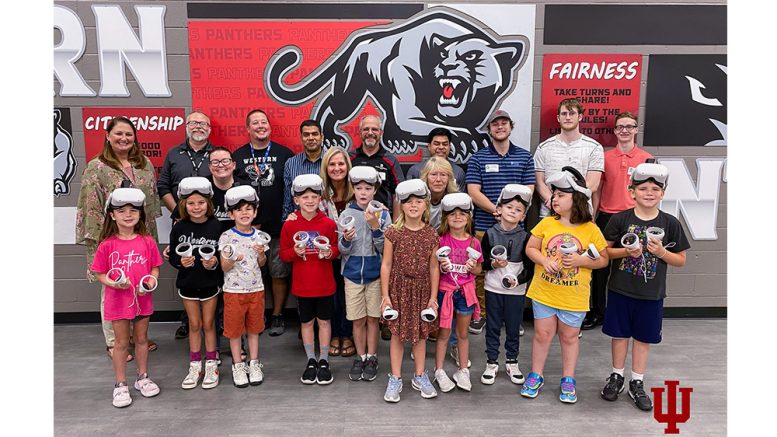Submitted
Increased math skills among primary school students could equal increased numbers of computer science students in college.
That’s the goal of a math education program being piloted at a Howard County school by Md Nour Hossain, assistant professor of computer science and informatics at Indiana University Kokomo.
Computer science students Ben Earl, Ricardo Esquivel, and Connor Schweck, all from Noblesville; and Nick Thomson, Kokomo, have worked with Hossain to develop virtual reality math games for first and second graders at Western Primary School in Howard County, with plans to expand into other area schools.
During weekly visits to the school, the team supervises as children put on Oculus Quest 2 virtual reality headsets and step into games designed to increase their computational skills.
Hossain developed the program while working on a solution to high attrition rates in college computer science programs. While some obstacles students face can be addressed, weak computational skills may be nearly impossible to overcome in a computer science program.
He realized that by introducing computational thinking at the earliest grades, students would be better prepared for computer science programs – but it would be difficult for an elementary teacher to reach that goal with large class sizes.
“I started thinking about how we can give them one-to-one teaching, so they can master math and also keep a focus on computational thinking,” Hossain said. “The benefits are that it will help K-12 students master math, and master computational thinking, with a long-term goal of having more students ready for computer science and informatics. If their math skills are good, they will also be ready for many other science fields as well.”
Hossain and his team started with games to encourage number sense, first putting children in a world with no numbers and asking them to set a table for a birthday party without giving a number of guests attending. This makes it impossible to set the right number. Then, the children perform the task knowing the number of guests and can successfully complete it.
“It gives them a sense that numbers make our lives easier, numbers are everywhere, and we need them every day,” Hossain said.
The games developed by the student team build on one another, progressively adding more information as they go.
Thomson said they researched Indiana’s common core math standards in developing lessons. One of their biggest challenges is taking information they know and figuring out how to make it interesting and understandable to very young children.
“We’re trying to give them a good foundation in mathematics,” Thomson said. “We’re college students trying to teach elementary children. Getting yourself in that frame of mind is challenging.”
Earl noted for the first and second graders, they built in audio instruction after learning that not all children this age can read well.
The computer science students are also learning as they plan virtual reality lessons.
“This is a full-fledged application they are developing, and real people are using,” Hossain said. “Right now, there is no application that exists in this category to target preschool, elementary, or high school. Gaming is a big industry. From my computer science perspective, they will master the programming language and it will open a potential career field for them.”
Schweck said the program is bigger than a class project.
“It gives kids a route to computer science,” he said. “They are amazed when they find out we made this game. It gets them interested in computer science, and what we do.”
Esquivel said the game engages the students.
“It shows them that learning can be fun,” he said.
Hossain’s goal is to publish a research paper linking their game to improvement in learning math and computational thinking. Once they can do that, he hopes to partner with other schools to provide the headsets and program, eventually making it available for all K-12 grades nationwide.

